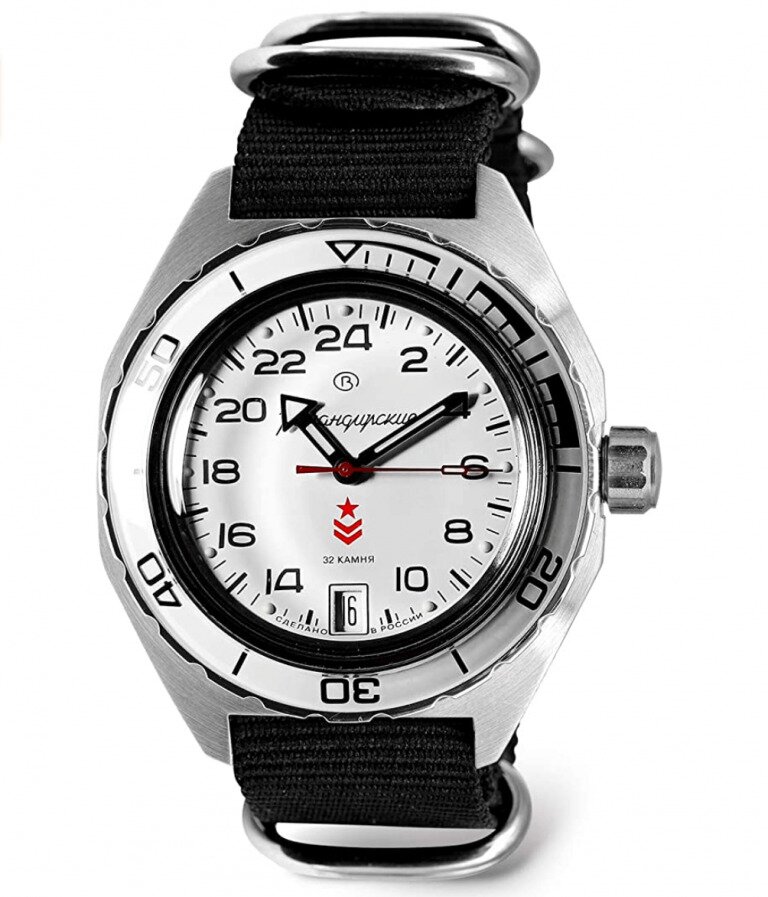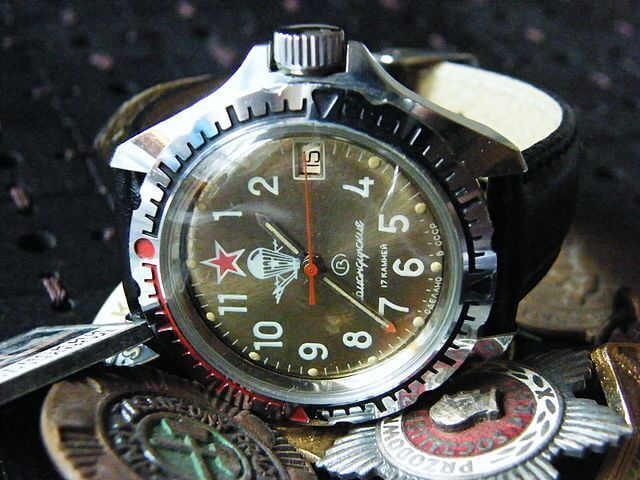Watches
Zen & the Art of Vostok Watch Maintenance
My first car was a 1969 Ford Mustang, and that came with all the frustrations and steep learning curves you might imagine if you take a moment to. She needed my attention like adopting a pet with a myriad of chronic illnesses. The drum brakes needed my entire body weight on the pedal to stop the car. The windows fogged at the worst times. However, it had the panache I always wanted. The candy apple red paint job and the AM radio blasting oldies out of a mono speaker made me feel like I owned the car I repeatedly drew with a crayon when I was in kindergarten.
It wasn’t like driving an appliance like most cars. Driving that car was like putting on a costume. At the time, I was living in a city that was peppered liberally with wealth, and there was nothing stealth about it. While my peers were often driving around in or hounding after brand new, resale-white, Mercedes, I was driving something that stood out and felt unique, and at a fraction of the cost. This is how I’ve felt all my life about Vostok watches.
Table of Contents
Watches are so often seen as a sign of success. So many men sport a full on arm-clock that can be seen from Neptune. A contemporary watch can run easily over a thousand dollars, and for many, so much more. You can get a vintage Vostok for under a hundred dollars, and in so many styles from a variety of eras. Are you going to be flashing it around the yacht club? Not likely. But you’ll get asked about it the same way you would driving a vintage car. Vostok fanatics (of which, I admit, I am one) will insist that no watch collection is complete without owning one. They’re a special genre of watch that likely has the most truly cultish following of all the brands, and with good reason.
The Acquisition
When I was ten years old, my father left Canada for an extended period of time to work in the Yugoslav Wars. As a counter terrorist with a history in customs, he, along with a large battalion of Norwegians, went to assist in the newly formed borders of the countries that declared independence from Yugoslavia, ultimately crumbling that country into pieces. When he returned, after he was pushed by my siblings and I to have his first proper shower in a while, he presented my brother and I with Vostoks. When the Soviet Union dissolved, everything from nuclear submarines to military apparel was sold off at a swift rate. The komandirskie Vostoks, which were worn by submariners, were part of the fire sale, and many made their way to Yugoslavia. I wore that watch from that age forward, it bangling around my tiny wrist from then until I got old enough to not look like I was wearing my father’s old clothes. In every party photo from my twenties, to more formal affairs like weddings, my komandirskie was on me. Of course, as any Vostok fan will tell you, it can develop one of those chronic illnesses.
The Value (Beyond $$$)
Ask most who wear sixty-thousand-dollar watches on their wrists why they do so, and you’ll get a variety of answers that almost all lead to some version of “I like something that’s made with craftsmanship and precision.” I’m not about to debate that here, but I did see a man on Youtube say that if that’s what you’re after, you could also just own an MRI machine. So instead of making the case against having a Mercedes Benz on your arm, I’ll speak to the joy a vintage Vostok can bring a person. There’s a philosophical thought that as much as we yearn to, we can’t go back in time, so we go back in space instead. People drive by their old houses they grew up in. They (read: me) buy old cars, old band t-shirts, or get a clawfoot tub for their bathrooms. Even without making the “buy it for life” case against modern planned obsolescence, there is as much craftsmanship, precision, and time put into an older watch. Additionally, if you’re lucky, there’s a story there.
My story left me with a non-working Vostok with sentimental value sitting on my shelf for a few years. Specifically, it didn’t keep time properly anymore. I found the oldest jeweler in my city and took the watch in. A week later I was told that, even between all the experts, they couldn’t fix it. The pieces were just not compatible. With a sigh, I began the walk home where I thought about the Iron Curtain and how, although the race of technology between the Soviets and the West was often equal, they got to the same places but took different routes. It made logical sense to me that the pieces inside my old Vostok were not easily repaired by a western expert. Walking by my place of work, I noticed that the tiny hair salon on the block also fixed watches. At a desk in the corner of a women’s salon sat an old Chinese gentleman. I asked him if he fixed Soviet watches. “Soviet?” he asked the air above him. “Oh, communist watch! Yeah, give it here.” Looking at it for less than thirty seconds he told me to come back in fifteen minutes and make sure I had ten dollars. The watch was fixed. The komandirskie lifestyle began again.
There are reasons to wear a watch for more than bravado. There can be lifelong narratives.
The Soviet Way: Precise and Economical
Okay, so those uninitiated to the Soviet watch world will ask the valid question: Why are Vostoks so inexpensive? Firstly, Russian labor is cheap. It’s always been cheap, and it continues to be. Also, like the Ford Mustang, they made millions of them. They weren’t a fancy watch. They were made for the working man, the sailor, or the merchant. The Vostok was a gift for a good deed, or a birthday. Especially pre perestroika, the average person in Russia was just that: average. The Union was made on the idea of a great average economically, and with it came a precise and economical way of making a watch. The Vostok was not designed and redesigned until perfected, nor was it re-modeled for every year in an attempt to have the newest one. It’s much like the famous British car the Morgan: it has not changed. In classic Soviet fashion, they claim the watch was designed perfectly the first time, and that’s how it is always going to be. A Vostok is a Vostok. It’s like owning a good set of screwdrivers. The pieces fit, and they are uniform.
The Road to Refurbishment
I wore my Vostok in the bathtub. In my defense, the Cyrillic on the back said it was waterproof. Anyway, it stopped working, and the jewelers in Montreal, even after keeping it for months, told me it was beyond repair. So, off to the Balkans I went, to the original source of my beloved watch. Touring around the Old Bazaar area of Skopje, I came across a small antique shop run by a polite man named Bekim. He had walls of vintage watches, and I spied a few Vostoks. Over the coming weeks, I returned to his shop to begin collecting even more from this era of the watch brand I’d had on my wrist most of my life. I bought one commemorating Soviet space hero Yuri Gargarin. I got one that honored Boris Yeltsin, which needs a little shake to wake up and work sometimes, not unlike the actual Yeltsin. But my watch needed repair, and Bekim told me he’s more of a collector than a maker, and can do only so much. He generously locked his shop up, and led me deeper into the Old Bazaar, and that’s where I met Fasil.
Fasil was sitting behind his table, smoking cigarettes. In his display cases were thousands of parts of watches so small, the piles often looked like one mass. On the wall were sun-stained posters of brands of watches and electronics I had never heard of. Fasil himself, a sixty-one-year-old Turkish man, whose English was limited to a few words, spoke to Bekim, who translated for me. Fasil took my watch, opened it immediately, and told me he needed twenty-four hours and one thousand Macedonian denars (around $20 USD). I left my watch with him, and thanked them both. Upon return, I had my Vostok back and in better working condition than I felt it ever had been in. Fasil and I communicated nonverbally for some time. We shared our history with watches. He allowed me to observe as he worked on some. He eventually conveyed to me that that day, being the first day of Ramadan, his brain wasn’t working as he preferred, due to no coffee or cigarettes. He asked me to return when Ramadan ends to spend time, and my hope is he understood me when I told him it would be my absolute pleasure.
The Reward
Mr. Fezziwig in Dickens’ A Christmas Carol said, “It’s not just for money alone that one spends a lifetime building up a business. It’s to preserve a way of life that one knew and loved.” There are reasons to wear a watch for more than bravado. There can be lifelong narratives. Even when they break down, there are opportunities for a “Zen and the Art of Vostok Maintenance” satisfaction. As any Vostok collector like myself will tell you: consider one for your collection. And if you ever see the one with Laika the Soviet space dog on it, let me know.

Vostok (in Russian, Восток — literally meaning “East”) Watch Makers is a Russian watch company founded in 1942. Affordable, durable and a great conversation piece, the Vostok Komandirskie would make a great addition to any man’s watch collection.
Vostok K-65 automatic self-winding Russian Military watch with 24-hour dial.

